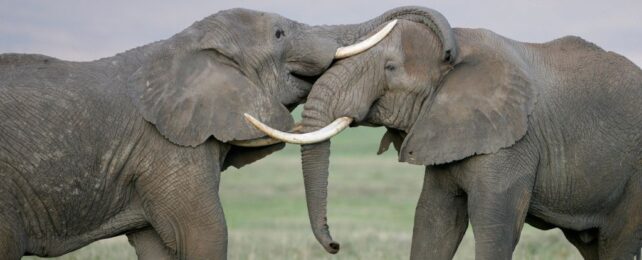As elephants wander the African savannah, they might keep in touch with relatives by calling out their individual 'names'.
Researchers have found evidence that wild savannah elephants in Kenya label each other with specific vocal sounds, which they then use to communicate.
The research is not yet peer-reviewed, but if the results can be verified and reproduced, it would make elephants the only known non-human animal to communicate with random names.
Bottlenose dolphins can also call to certain individuals by imitating their unique signature whistles, but scientists say this is slightly different from what we humans do.
Our names aren't usually based on imitations of unique noises we make ourselves (like Pikachu), but are generally reflections of something more abstract and less tangible, buried in cultural practices and values.
It is this arbitrary nature of human naming that now seems to apply to elephants, too.
In a lecture available on YouTube, behavioral ecologist Michael Pardo from Colorado State says his team's findings potentially "blur the line" between "what we think is unique to human language versus what is found in other animal communication systems."
Elephants are known for their loud, trumpet-like vocalizations, but the vast majority of their communication can't actually be heard by humans.
Instead, these large mammals mostly produce low-frequency rumbles, which can deliver messages to the feet of other elephants as far as six kilometers away.
Elephants spend the vast majority of their day in search of food, and it's not uncommon for the herd to lose sight of each other in that endeavor. Calling each other by names would be a useful way to keep tabs on the herd.
To explore that possibility, Pardo and his colleagues spent hours recording elephant rumbles in the wild, at two separate locations in Kenya.
Altogether, the team amassed 625 rumbles. Some of these were contact rumbles, like the ones described above, while others were greeting rumbles, which occur when elephants see each other again after some time apart.
Analyzing various features of these rumbles, researchers used a machine learning model to correctly predict which receiver the rumble was directed towards. The results suggest that certain rumbles were specific to individual receivers, and that those sounds did not rely on imitation of the receiver.
When scientists played back some of these rumbles to 17 wild elephants, individuals moved more quickly toward the sound of their own 'name' and vocalized faster in response, too.
What's more, these vocal labels seemed to be relatively consistent across the herd.
In other words, different elephants often used the same sort of rumbles to communicate with the same receiver, and these vocal labels were not just for broad societal roles, like 'mother'.
Of all the rumbles recorded among elephants in Kenya, only about a fifth were identified as individual vocal labels, but this is quite similar to how humans use names as well. Oftentimes, names aren't necessary in a situation, or they are just one component of a much larger point.
Elephant rumbles are theorized to encode a whole variety of messages, from age to sex to emotional state, and in some scenarios, these could very well take precedence over a name.
"Rather than comprising a whole stand-alone call, elephant vocal labels may be embedded within a call that simultaneously conveys multiple additional messages," the researchers explain.
"The richness in the information content of elephant vocalizations makes it difficult to identify the specific acoustic parameters that encode receiver ID."
The findings suggest artificial intelligence programs really can help us better understand the nuances of animal communication.
Maybe one day researchers can even use this knowledge to call elephants by their names.
The pre-print is available on bioRxiv.
